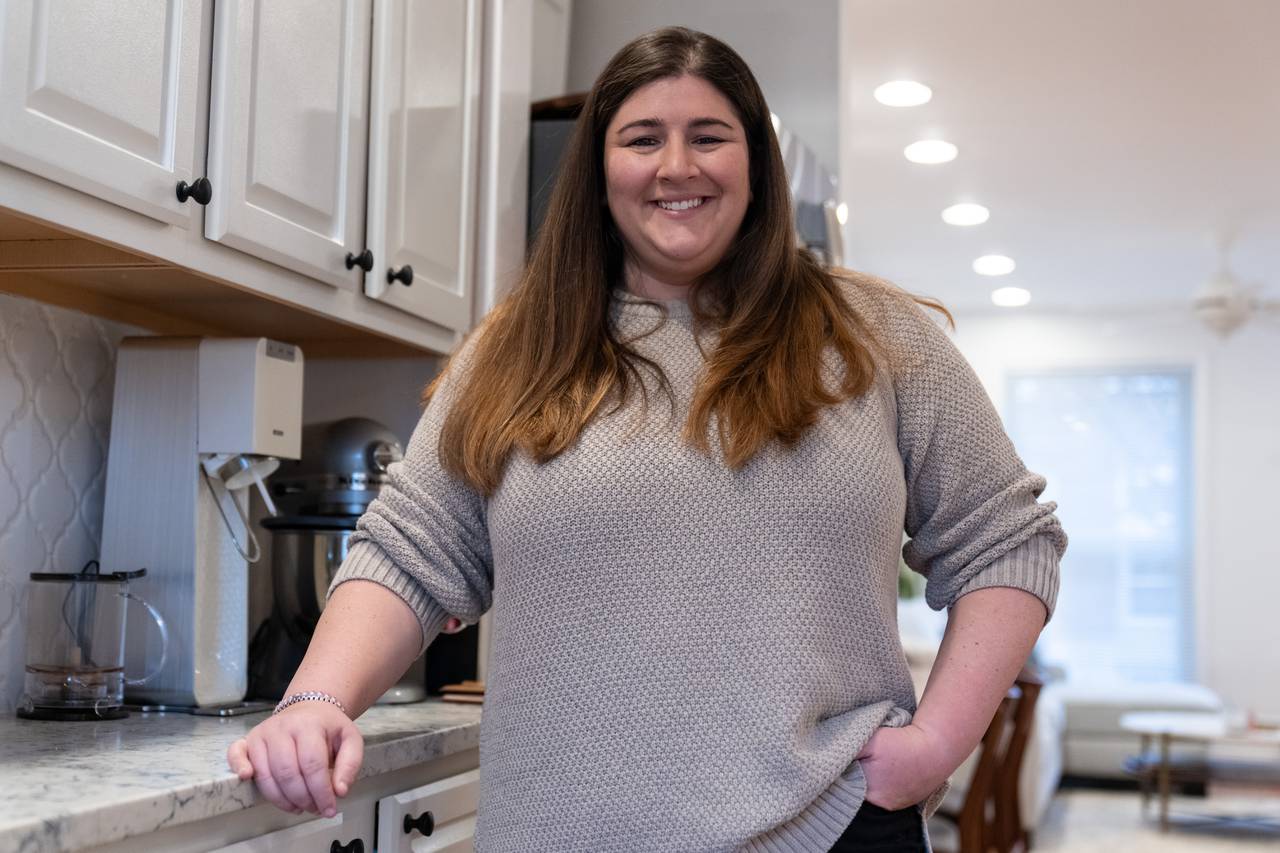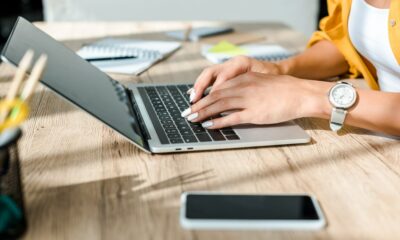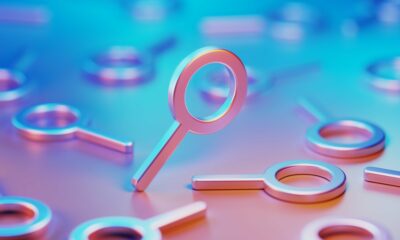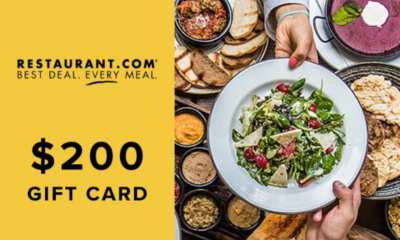SOCIAL
Baltimore food influencers do it for the ‘gram. Do restaurants benefit?
The Cake Out Maryland bakery in Columbia was a labor of love for sisters Sade and Azia Castro.
Between traveling nurse gigs, Sade Castro would take orders over social media for the sweets otherwise found only in the Philippines, advertising flavors from ube flan to chiffon cake with a milky caramel glaze. But few outside their community knew of the shop.
Castro saw foodies on Instagram in videos that garnered thousands of likes and followers. More people had to be searching for “Asian tastes” in Maryland and Virginia, she thought. Why couldn’t her cakes be the next viral sensation?
So she reached out to a food influencer.
Over the last few years in Baltimore, the practice of connecting restaurants and burgeoning food businesses with social media personalities has become increasingly common, according to public relations executive Dave Seel, who has built an arm of his Blue Fork marketing firm for the task.
“There can be a dearth of coverage for certain subsections of the city,” he said. “Influencers have taken up that space and used it to build followership.”
Baltimore is a small city, especially in food media. There is no Eater, Infatuation or Michelin Guide. People are thirsting for creative, diverse angles, Seel said.
With the rise of food influencers in Baltimore comes an opportunity to provide platforms to communities, voices and cuisines that have been traditionally alienated. But this wave of restaurant marketing has also raised questions about the authenticity of social media tastemakers and where the quest for that viral video leaves small businesses, many of whom are fighting for survival following the pandemic.
Marketing is an extension of community building, Seel said, and to that end, some restaurants have modified their aesthetics to attract new customers over social media.
Seel cited BLK Swan in Harbor East as a prime example for its well-advertised community events and “selfie walls.” Customers cannot visit Gunther and Company on Toone Street without taking photos by its “Instagram-worthy living green wall,” he said. At times, he has recommended that restaurants invest in a “particularly ooey, gooey picture-worthy” dish.
It does not always go viral or attract the attention needed to generate business, but it’s an increasingly popular strategy.
“Has it eclipsed all other strategies? I don’t necessarily think so. … But do [influencers] have a seat at the table? Absolutely,” Seels said. “You can’t ignore it.”
‘It’s a marketing job’
Tim “Chyno” Chin always dreamed of hosting his own television show about food.
He grew up an army brat, born in Germany and shuttled between bases before landing in Sandtown-Winchester, a Baltimore food desert. It was not “lavish,” he said; food was utilitarian and purchased with food stamps. There was no one like him on TV: Black, Chinese and gay. But as Chin remembers, he had a “charisma” that allowed him to persevere.
Chin now considers himself part of a “freshman class” of influencers who rose to foodie fame before the local restaurant industry came to embrace the world of social media marketing. Until about six years ago, eateries looking for publicity were beholden to legacy media platforms. The big players trusted to show Baltimoreans where to eat were radio personalities like Downtown Diane and Dara Cooks, he said.
“We slowly started replacing that,” Chin said. “They didn’t understand [social media] was going to catch on the way it did.”
Chin had worked in kitchens and as a server, so he believed he could relay the importance of a social media presence to the old guard of small businesses. He started by running the social media of the former Joe Squared in Power Plant Live, and then shooting food pictures at the now-shuttered Pinch Dumplings in Mount Vernon Marketplace in exchange for free meals.
“I would post something and then a restaurant would sell out of it,” he said, calling it “the Chyno effect” — a byproduct of his time hosting a YouTube show. He’s now garnered followers as “The Baltimore Foodie” and “The Boy with the Blue Beard,” building a more-than-135,000-person Instagram following and appearing as a host for the “Fresh, Fried and Crispy” show on Netflix.
“I’ve got an Emmy waiting for me somewhere,” he told The Banner.
To show restaurants he was serious, Chin drew up a rate sheet for his services. “A lot of influencers have it,” he said. The sheet explains an influencer’s cost per post, Instagram reel, links, video and stories. “Everything has a monetized value.” Chyno did not say how much he charges, but as his audience across platforms rises, so does his value.
“People don’t understand this is hard,” he said. “You have to constantly evolve with technology, learn algorithms, follow these trends. … It’s a marketing job.”
TikTok celebrities like MMA fighter turned foodie Keith Lee, who recently made news for a video critiquing the service at an Atlanta restaurant, can change an eatery’s reputation with a single post.
Anybody can call themselves an influencer, Seel said, but “it doesn’t mean they have a core following or an engaged following that really creates the marketing effect that can get restaurateurs that return on investment.”
‘It’s such a difficult thing to decide what you’re worth’

The world of social media marketing is still largely uncharted. The Federal Trade Commission has codified guidelines on sponsorship transparency for influencers, going as far as to issue $50,000 penalties for failures to adequately disclose paid partnerships.
According to estimates from Insider Intelligence, more than $6.1 billion is expected to be spent nationwide this year on influencer marketing.
Local influencer Rachel Lipton learned about rate sheets herself in 2017 when 7-Eleven offered her $100 to post its iced tea on her “like the tea eats” Instagram page.
“My wife pulled me aside and said, ‘I think you should be charging these large businesses,’” said Lipton, who already had a full-time job. “It’s such a difficult thing to decide what you’re worth.”
Her pricing varies. Video content took far longer to edit, so she charged more. Her rates also went up depending on the size of the company inquiring about a post. She also is particular about who she will work with — or not. She said she will never post about Chick-fil-A due to their alleged culture of homophobia. And since news broke in 2020 of Ouzo Bay allegedly discriminating against a Black woman and her son, along with follow-up complaints against the owners, Atlas Restaurant Group, Lipton has promised not to promote dining at their restaurants.
Kimberly Kong, the creator of a series of food photography pages known as Nomtastic Baltimore and Nomtastic D.C., has amassed more than 100,000 followers, in part, for making a point of dining at Asian-inspired small businesses in Maryland and Virginia.
“I let [businesses] know that you’re only going to get featured if I genuinely like your food. And it’s going to be disclosed that I was invited and food was comped,” Kong said. Yet she cringes at the “influencer” title and the lack of authenticity it evokes. A large number of her posts were not paid for, she said, and were born out of an interest in wanting to try new spots.
Kong also does not charge small businesses for promotion, citing pandemic-era losses as a reason for many of them to be skeptical of investing in the world of social media marketing. Chin and Lipton also said they offered reduced rates to try and boost local spots.
“I understand the restaurants’ point of view with how slim the margins are and how tough it is right now,” Kong said.
‘Every time we posted something, it just got sold’
Sade Castro never met the Instagram celebrity that sparked an interest in her Maryland shop.
Neither did her sister and business partner, who repeatedly called Castro “crazy” for inviting someone with more than 100,000 followers to sample their cakes. For three years, the two-person bakery had sold the desserts almost exclusively to a group of Filipino moms over Facebook — and even then, they struggled to meet demand.
“I trust that you really believe in your food recs and that you’ve actually tried and loved every food post,” Castro wrote to Kong on Sept. 9. “With that, I would like you to try our Filipino-style cakes.”
Shortly after, Castro was leaving a sampler of nine cakes at Kong’s door.
On Sept. 21, Kong posted footage of her digging into a gooey can of chocolate cake and slowly slicing into the ube flan’s purple center.
“I was at work when my phone started to go off,” Castro said. Within a day, the video had gone viral. The number of people viewing the bakery’s Instagram page rose by over 900% in a matter of hours, and then again by another 2,000% by the end of the week. About 3,000 new people had followed their rarely updated Instagram by the end of September.
“Why would you do this?” Castro remembered her sister asking. “It’s just the two of us, we’re baking from home, and we have full-time jobs.”
The bakery that had provided roughly 120 cakes each year catering to their Filipino neighbors had received hundreds of orders in a matter of days. “We were messaging people saying we don’t have [the cakes],” she said.
Unable to meet demand, they started a lottery. By the end of October, the attention faded some, with viewers of their content down by 42%, according to Castro’s Instagram analytics. Still, the success of the post presented an opportunity for Castro’s self-proclaimed “side hustle.” “Every time we posted something, it just got sold,” she said.
But a restaurant has to be ready. Seel explained that influencers will often receive a tailored experience: sampler cakes, private dining and even custom sandwiches. The business has to be able to execute at the same level for the regular customers, too.
In October, Fells Point eatery Little Donna’s claimed to be “screwed” after a New York Times critic placed the business on the paper’s list of most exciting places to eat. The now-shuttered Local Oyster also faltered in the spotlight after an influencer-promoted sandwich spurred high demand and community backlash, forcing it to be 86ed from the menu.
“All of a sudden, there can be an onslaught of people and it’s hard to keep up,” Seel said.
Castro has no regrets about Kong’s effect on her business. As of November, Cake Out is searching for ways to increase output and serve the Filipino neighbors who had leaned on them for their traditional holiday treats. Plans to move to a larger kitchen are in the works, due to the support from new customers, Castro said.
“For now, we are grateful.”
SOCIAL
12 Proven Methods to Make Money Blogging in 2024

 This is a contributed article.
This is a contributed article.
The world of blogging continues to thrive in 2024, offering a compelling avenue for creative minds to share their knowledge, build an audience, and even turn their passion into profit. Whether you’re a seasoned blogger or just starting, there are numerous effective strategies to monetize your blog and achieve financial success. Here, we delve into 12 proven methods to make money blogging in 2024:
1. Embrace Niche Expertise:
Standing out in the vast blogosphere requires focus. Carving a niche allows you to cater to a specific audience with targeted content. This not only builds a loyal following but also positions you as an authority in your chosen field. Whether it’s gardening techniques, travel hacking tips, or the intricacies of cryptocurrency, delve deep into a subject you’re passionate and knowledgeable about. Targeted audiences are more receptive to monetization efforts, making them ideal for success.
2. Content is King (and Queen):
High-quality content remains the cornerstone of any successful blog. In 2024, readers crave informative, engaging, and well-written content that solves their problems, answers their questions, or entertains them. Invest time in crafting valuable blog posts, articles, or videos that resonate with your target audience.
- Focus on evergreen content: Create content that remains relevant for a long time, attracting consistent traffic and boosting your earning potential.
- Incorporate multimedia: Spice up your content with captivating images, infographics, or even videos to enhance reader engagement and improve SEO.
- Maintain consistency: Develop a regular publishing schedule to build anticipation and keep your audience coming back for more.
3. The Power of SEO:
Search Engine Optimization (SEO) ensures your blog ranks high in search engine results for relevant keywords. This increases organic traffic, the lifeblood of any monetization strategy.
- Keyword research: Use keyword research tools to identify terms your target audience searches for. Strategically incorporate these keywords into your content naturally.
- Technical SEO: Optimize your blog’s loading speed, mobile responsiveness, and overall technical aspects to improve search engine ranking.
- Backlink building: Encourage other websites to link back to your content, boosting your blog’s authority in the eyes of search engines.
4. Monetization Magic: Affiliate Marketing
Affiliate marketing allows you to earn commissions by promoting other companies’ products or services. When a reader clicks on your affiliate link and makes a purchase, you get a commission.
- Choose relevant affiliates: Promote products or services that align with your niche and resonate with your audience.
- Transparency is key: Disclose your affiliate relationships clearly to your readers and build trust.
- Integrate strategically: Don’t just bombard readers with links. Weave affiliate promotions naturally into your content, highlighting the value proposition.
5. Display Advertising: A Classic Approach
Display advertising involves placing banner ads, text ads, or other visual elements on your blog. When a reader clicks on an ad, you earn revenue.
- Choose reputable ad networks: Partner with established ad networks that offer competitive rates and relevant ads for your audience.
- Strategic ad placement: Place ads thoughtfully, avoiding an overwhelming experience for readers.
- Track your performance: Monitor ad clicks and conversions to measure the effectiveness of your ad placements and optimize for better results.
6. Offer Premium Content:
Providing exclusive, in-depth content behind a paywall can generate additional income. This could be premium blog posts, ebooks, online courses, or webinars.
- Deliver exceptional value: Ensure your premium content offers significant value that justifies the price tag.
- Multiple pricing options: Consider offering tiered subscription plans to cater to different audience needs and budgets.
- Promote effectively: Highlight the benefits of your premium content and encourage readers to subscribe.
7. Coaching and Consulting:
Leverage your expertise by offering coaching or consulting services related to your niche. Readers who find your content valuable may be interested in personalized guidance.
- Position yourself as an expert: Showcase your qualifications, experience, and client testimonials to build trust and establish your credibility.
- Offer free consultations: Provide a limited free consultation to potential clients, allowing them to experience your expertise firsthand.
- Develop clear packages: Outline different coaching or consulting packages with varying time commitments and pricing structures.
8. The Power of Community: Online Events and Webinars
Host online events or webinars related to your niche. These events offer valuable content while also providing an opportunity to promote other monetization avenues.
- Interactive and engaging: Structure your online events to be interactive with polls, Q&A sessions, or live chats. Click here to learn more about image marketing with Q&A sessions and live chats.
9. Embrace the Power of Email Marketing:
Building an email list allows you to foster stronger relationships with your audience and promote your content and offerings directly.
- Offer valuable incentives: Encourage readers to subscribe by offering exclusive content, discounts, or early access to new products.
- Segmentation is key: Segment your email list based on reader interests to send targeted campaigns that resonate more effectively.
- Regular communication: Maintain consistent communication with your subscribers through engaging newsletters or updates.
10. Sell Your Own Products:
Take your expertise to the next level by creating and selling your own products. This could be physical merchandise, digital downloads, or even printables related to your niche.
- Identify audience needs: Develop products that address the specific needs and desires of your target audience.
- High-quality offerings: Invest in creating high-quality products that offer exceptional value and user experience.
- Utilize multiple platforms: Sell your products through your blog, online marketplaces, or even social media platforms.
11. Sponsorships and Brand Collaborations:
Partner with brands or businesses relevant to your niche for sponsored content or collaborations. This can be a lucrative way to leverage your audience and generate income.
- Maintain editorial control: While working with sponsors, ensure you retain editorial control to maintain your blog’s authenticity and audience trust.
- Disclosures are essential: Clearly disclose sponsored content to readers, upholding transparency and ethical practices.
- Align with your niche: Partner with brands that complement your content and resonate with your audience.
12. Freelancing and Paid Writing Opportunities:
Your blog can serve as a springboard for freelance writing opportunities. Showcase your writing skills and expertise through your blog content, attracting potential clients.
- Target relevant publications: Identify online publications, websites, or magazines related to your niche and pitch your writing services.
- High-quality samples: Include high-quality blog posts from your site as writing samples when pitching to potential clients.
- Develop strong writing skills: Continuously hone your writing skills and stay updated on current trends in your niche to deliver exceptional work.
Conclusion:
Building a successful blog that generates income requires dedication, strategic planning, and high-quality content. In today’s digital age, there are numerous opportunities to make money online through blogging. By utilizing a combination of methods such as affiliate marketing, sponsored content, and selling digital products or services, you can leverage your blog’s potential and achieve financial success.
Remember, consistency in posting, engaging with your audience, and staying adaptable to trends are key to thriving in the ever-evolving blogosphere. Embrace new strategies, refine your approaches, and always keep your readers at the forefront of your content creation journey. With dedication and the right approach, your blog has the potential to become a valuable source of income and a platform for sharing your knowledge and passion with the world, making money online while doing what you love.
Image Credit: DepositPhotos
SOCIAL
Snapchat Explores New Messaging Retention Feature: A Game-Changer or Risky Move?

In a recent announcement, Snapchat revealed a groundbreaking update that challenges its traditional design ethos. The platform is experimenting with an option that allows users to defy the 24-hour auto-delete rule, a feature synonymous with Snapchat’s ephemeral messaging model.
The proposed change aims to introduce a “Never delete” option in messaging retention settings, aligning Snapchat more closely with conventional messaging apps. While this move may blur Snapchat’s distinctive selling point, Snap appears convinced of its necessity.
According to Snap, the decision stems from user feedback and a commitment to innovation based on user needs. The company aims to provide greater flexibility and control over conversations, catering to the preferences of its community.
Currently undergoing trials in select markets, the new feature empowers users to adjust retention settings on a conversation-by-conversation basis. Flexibility remains paramount, with participants able to modify settings within chats and receive in-chat notifications to ensure transparency.
Snapchat underscores that the default auto-delete feature will persist, reinforcing its design philosophy centered on ephemerality. However, with the app gaining traction as a primary messaging platform, the option offers users a means to preserve longer chat histories.
The update marks a pivotal moment for Snapchat, renowned for its disappearing message premise, especially popular among younger demographics. Retaining this focus has been pivotal to Snapchat’s identity, but the shift suggests a broader strategy aimed at diversifying its user base.
This strategy may appeal particularly to older demographics, potentially extending Snapchat’s relevance as users age. By emulating features of conventional messaging platforms, Snapchat seeks to enhance its appeal and broaden its reach.
Yet, the introduction of message retention poses questions about Snapchat’s uniqueness. While addressing user demands, the risk of diluting Snapchat’s distinctiveness looms large.
As Snapchat ventures into uncharted territory, the outcome of this experiment remains uncertain. Will message retention propel Snapchat to new heights, or will it compromise the platform’s uniqueness?
Only time will tell.
SOCIAL
Catering to specific audience boosts your business, says accountant turned coach

While it is tempting to try to appeal to a broad audience, the founder of alcohol-free coaching service Just the Tonic, Sandra Parker, believes the best thing you can do for your business is focus on your niche. Here’s how she did just that.
When running a business, reaching out to as many clients as possible can be tempting. But it also risks making your marketing “too generic,” warns Sandra Parker, the founder of Just The Tonic Coaching.
“From the very start of my business, I knew exactly who I could help and who I couldn’t,” Parker told My Biggest Lessons.
Parker struggled with alcohol dependence as a young professional. Today, her business targets high-achieving individuals who face challenges similar to those she had early in her career.
“I understand their frustrations, I understand their fears, and I understand their coping mechanisms and the stories they’re telling themselves,” Parker said. “Because of that, I’m able to market very effectively, to speak in a language that they understand, and am able to reach them.”Â
“I believe that it’s really important that you know exactly who your customer or your client is, and you target them, and you resist the temptation to make your marketing too generic to try and reach everyone,” she explained.
“If you speak specifically to your target clients, you will reach them, and I believe that’s the way that you’re going to be more successful.
Watch the video for more of Sandra Parker’s biggest lessons.
-

 PPC7 days ago
PPC7 days agoHow the TikTok Algorithm Works in 2024 (+9 Ways to Go Viral)
-

 SEO6 days ago
SEO6 days agoHow to Use Keywords for SEO: The Complete Beginner’s Guide
-

 MARKETING7 days ago
MARKETING7 days agoHow To Protect Your People and Brand
-

 MARKETING4 days ago
MARKETING4 days agoAdvertising on Hulu: Ad Formats, Examples & Tips
-

 MARKETING5 days ago
MARKETING5 days agoUpdates to data build service for better developer experiences
-

 WORDPRESS4 days ago
WORDPRESS4 days agoBest WordPress Plugins of All Time: Updated List for 2024
-

 MARKETING1 day ago
MARKETING1 day ago18 Events and Conferences for Black Entrepreneurs in 2024
-

 MARKETING6 days ago
MARKETING6 days agoThe Ultimate Guide to Email Marketing













